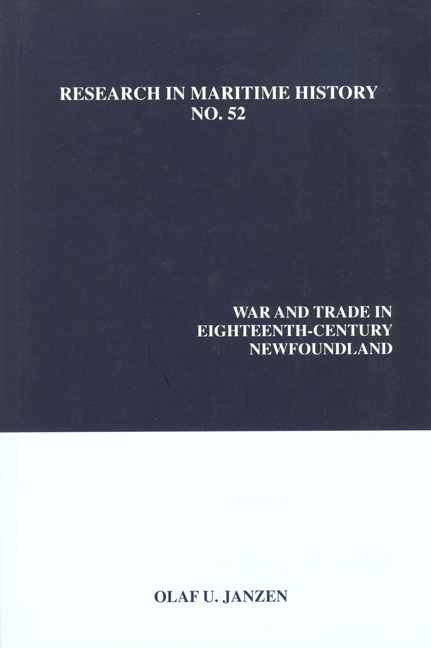Book contents
- Frontmatter
- Table of Contents
- About the Author
- Introduction
- “‘A World Embracing Sea:’ The Oceans as Highway, 1604-1815”
- “Of Consequence to the Service:' The Rationale behind Cartographic Surveys in Early Eighteenth-Century Newfoundland”
- “The Problem of Piracy in the Newfoundland Fishery in the Aftermath of the War of the Spanish Succession”
- “A Scottish Sack Ship in the Newfoundland Trade, 1726-1727”
- “'Une petite Republique' in Southwestern Newfoundland: The Limits of Imperial Authority in a Remote Maritime Environment”
- “The Illicit Trade in English Cod into Spain, 1739-1748”
- “Un Petit Dérangement: The Eviction of French Fishermen from Newfoundland in 1755”
- “The French Raid upon the Newfoundland Fishery in 1762: A Study in the Nature and Limits of Eighteenth-Century Sea Power”
- “Showing the Flag: Hugh Palliser in Western Newfoundland, 1763-1766”
- “The Royal Navy and the Interdiction of Aboriginal Migration to Newfoundland, 1763-1766”
- “The Royal Navy and the Defence of Newfoundland during the American Revolution”
- “The American Threat to the Newfoundland Fisheries, 1776-1777”
- Appendix
“The Problem of Piracy in the Newfoundland Fishery in the Aftermath of the War of the Spanish Succession”
- Frontmatter
- Table of Contents
- About the Author
- Introduction
- “‘A World Embracing Sea:’ The Oceans as Highway, 1604-1815”
- “Of Consequence to the Service:' The Rationale behind Cartographic Surveys in Early Eighteenth-Century Newfoundland”
- “The Problem of Piracy in the Newfoundland Fishery in the Aftermath of the War of the Spanish Succession”
- “A Scottish Sack Ship in the Newfoundland Trade, 1726-1727”
- “'Une petite Republique' in Southwestern Newfoundland: The Limits of Imperial Authority in a Remote Maritime Environment”
- “The Illicit Trade in English Cod into Spain, 1739-1748”
- “Un Petit Dérangement: The Eviction of French Fishermen from Newfoundland in 1755”
- “The French Raid upon the Newfoundland Fishery in 1762: A Study in the Nature and Limits of Eighteenth-Century Sea Power”
- “Showing the Flag: Hugh Palliser in Western Newfoundland, 1763-1766”
- “The Royal Navy and the Interdiction of Aboriginal Migration to Newfoundland, 1763-1766”
- “The Royal Navy and the Defence of Newfoundland during the American Revolution”
- “The American Threat to the Newfoundland Fisheries, 1776-1777”
- Appendix
Summary
In his classic History of Newfoundland, written at the close of the last century, Daniel Woodley Prowse dismissed the period from 1714 to 1727 as akin to “the heavy prosaic Hanoverian monarch – dull, uneventful, peaceful, and prosperous.” In fact, we now know that it was a period of profound changes and hardships in the fishery, frequently tumultuous and punctuated occasionally by moments of violence and terror. It was a period when the inshore fishery failed, causing such widespread destitution among the permanent residents that one observer was led to remark that they were “worse off than negroes and slaves.” It was an age when British policy was guided by the firm conviction that Newfoundland was a seasonal fishing station which required no government, no courts, no constabulary, not even a militia. There were, in short, no institutions of law or order to contain the social tensions that ensued from the conditions that prevailed in Newfoundland after 1715. The owners of property in St. John's were sufficiently disturbed by what they perceived as the threat of lawlessness and anarchy that they established a court of law late in 1723. Conscious of the fact that they had no authority from England to do so – indeed, conscious that they were violating existing law practices and laws – they justified their initiative with reference to John Locke's Essay Concerning the True Original, Extant, and End of Civil Government (1690). It was also largely in consequence of the failure of the inshore fishery that, for the first time ever, the English began to send their fishing crews offshore to the great fishing banks. Finally, it was in the midst of all these profound stresses and responses that piracy returned – briefly but sharply – to Newfoundland. This paper seeks to explain the appearance of pirates in Newfoundland between 1717 and 1725. It will do so by placing developments in Newfoundland within the context of the general resurgence of piracy which occurred throughout the Anglo-American North Atlantic world during the decade after the conclusion of the War of the Spanish Succession. At the same time, it will link the appearance of pirates in Newfoundland to the particular needs of early eighteenth- century pirates as well as to the conditions that prevailed in the fishery after 1713.
- Type
- Chapter
- Information
- War and Trade in Eighteenth-Century Newfoundland , pp. 31 - 48Publisher: Liverpool University PressPrint publication year: 2013



